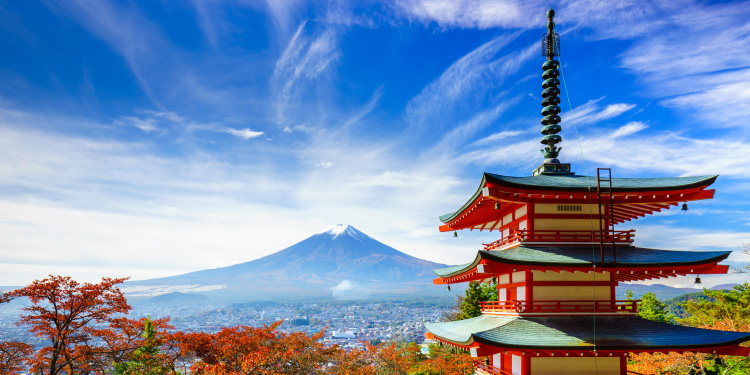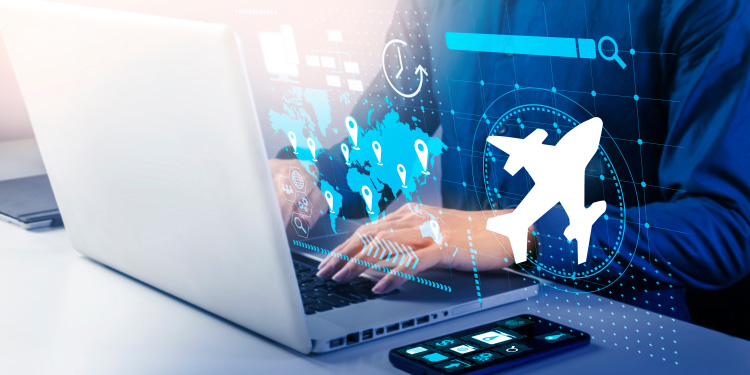The tourism industry, one of the key industries driving the Japanese economy, is growing rapidly as the number of foreign visitors and inbound consumption increases. While its abundant tourism resources are attracting worldwide attention, labor shortages are an issue, and thus foreign companies are expected to enter the industry.
Tourism and Hospitality
Government Initiatives

Promotion of Digitalization, Sustainable Tourism, and Regional Tourism to Boost Inbound Tourism and Further Develop the Tourism Industry
(1) Government Initiatives to Boost Inbound Tourism
The government is promoting the appeal of Japan's tourism and developing various marketing strategies to strengthen inbound tourism. The impact of the Expo 2025 Osaka, Kansai, Japan is also predicted to be significant, further boosting Japan's tourism industry.
One of the key marketing strategies is the global promotion of travel to Japan. In collaboration with private companies and local governments, tourism resources are disseminated through various approaches, and inbound tourism and international exchange are promoted.13
Also, based on the new Tourism Nation Promotion Basic Plan, the Inbound Marketing Strategy for FY 2023-FY 2025 has been formulated. To realize sustainable tourism, increase consumption, and promote regional attraction, it consists of three marketing strategies, including Strategy by Market (formulating market-specific strategies to increase consumption and promote tourist attraction to regional areas, based on the number of visitors who have been to Japan), Cross-market Strategy (high-value-added travel, adventure travel, Osaka-Kansai EXPO), and MICE Strategy (international conferences, incentive travel, etc.). In particular, under the Strategy by Market, marketing strategies have been formulated for each of the 22 countries and regions, aiming to strengthen regional attraction and raise awareness of regions in markets where many people have visited Japan before and repeat visitors are expected (the Asian region with a focus on East Asia), and in markets where people stay longer and are more interested in sustainable tourism (Europe and Canada)14 (Figure 5).
Figure 5: Excerpts from the Inbound Marketing Strategy (FY 2023-FY 2025)
| Strategy Type | Overview of focus areas (example) |
|---|---|
| Strategy by Market |
|
| Cross-market Strategy |
|
| MICE Strategy | Attract MICE events (*3) based on the changing needs of Osaka-Kansai EXPO, and the post-COVID-19 pandemic. |
At the Osaka-Kansai EXPO, events are being planned to leverage the Expo as an opportunity to showcase the excellence of Japan's manufacturing technologies, anime, and other content to domestic and foreign audiences, with production-induced economic effect projected to reach up to USD 22.24 billion* (JPY 3.4 trillion)16. It is a great opportunity to showcase Japan's appeal to the world and to boost the tourism industry.17
(2) Sustainable Tourism and Attracting Tourists to Regional Areas
In Japan, where the population is declining, tourism that fosters exchanges between foreign tourists and regional areas is seen as a trump card for regional revitalization. Approximately 90% of visitors who have already been to Japan, mainly high-income individuals from Asia, Europe, U.S, and Australia intend to visit regional areas, and as regional tourism in Japan is attracting more attention18, inbound consumption is likely to increase in regional areas. On the other hand, in response to growing international awareness, the Japanese government is aiming to realize sustainable tourism regions, and importance is likely to be placed on promoting sustainable tourism in regional areas while striving to balance economic use and conservation of regional tourism resources (nature, culture, history, and local industries).19
The promotion of sustainable tourism is based on the provision of nature and culture rooted in nature as well as the prevention and control of over-tourism.20 Furthermore, it is evident that the rapid increase in the number of tourists visiting regional areas not only has an economic impact on regional communities but also has a negative impact on each natural environment. There is a growing momentum within Japan to develop better communities for both local residents and tourists.21
The government has published the Japan Sustainable Tourism Standard for Destinations (JSTS-D) , and is providing support to regions working to create sustainable tourism regions by expanding related training and promoting the acquisition of international certifications and awards.22 With the support of the government, a total of six areas (Biei Town in Hokkaido, Niseko in Hokkaido, Oku-matsushima in Miyagi Prefecture, Hakuba Village in Nagano Prefecture, Shirakawa Village in Gifu Prefecture, and Miyama in Nantan City, Kyoto Prefecture) have been designated as Best Tourism Villages by the United Nations World Tourism Organization (UNWTO) as of 2023. Best Tourism Villages is a project to certify excellent regions (regions with a population of 15,000 or less and a primary industry) that are working to create sustainable tourism regions by conserving natural and cultural heritage through tourism.23 In the fourth Tourism Nation Promotion Basic Plan, the Japan Tourism Agency aims to increase the number of regions engaged in creating sustainable tourism regions to 100 and the number of internationally certified and awarded regions such as Best Tourism Villages to 50 by 2025.24
The fact that many foreigners intend to visit regional areas (excluding Tokyo, Osaka, and Kyoto) suggests that interest is growing not only in urban areas and famous tourist destinations but also in Japan's regional and non-urban areas. Even in the survey before the COVID-19 pandemic, visits to regional areas attracted considerable attention, now, especially among repeat visitors from Asia, such as Taiwan and Singapore, there is an increasing intention to visit local areas, which leads to expectation of an increase in the number of foreign tourists visiting regional areas (Figure 6).
Figure 6: Percentage of people who intend to visit regional areas of Japan (other than Tokyo, Osaka, and Kyoto) (top 22 countries and regions)

Source: Created by JETRO based on data from JNTO 25
⑶ Value-Added Businesses for Tourist Destinations and Tourism Industry Through Tourism Digital Transformation and ICT
The utilization of data collected through advanced digital technology and digitalization is essential to improve the profitability and productivity of the tourism industry as the number of visitors increases. In 2023, Japan Tourism Agency (JTA) announced a policy for realizing a regional revitalization and sustainable economic society through digital transformation in the tourism sector26 and is promoting the development of an environment for receiving inbound tourists using ICT and value-added support for tourist destinations and the tourism industry through digital transformation. There are issues such as improving the convenience of tourists by responding to travel styles and consumer needs, enhancing tourist destination management, and nurturing and utilizing tourism digital talent27, but it is believed that tourism digital transformation will be introduced in each region to address the issues.
Demonstration projects for tourism digital transformation are also underway to create advanced examples28, with initiatives aimed at maximizing profits by expanding tourist consumption, encouraging return visits, enhancing the profitability and productivity of the tourism industry, and strengthening data collaboration between businesses and regions.29
For example, the collection of best practices for promoting digital transformation in the tourism sector includes the following two domestic examples: firstly, Hakone, Kanagawa Prefecture, where a digital map equipped with traffic congestion information and reservation functions was introduced to show and recommend the optimal travel routes and tourism resources, thereby preventing over-tourism and promoting consumption by tourists, and secondly, Niseko, Hokkaido, where a centralized reservation system for experiential activities was introduced to increase profits while supporting effective management by providing aggregated data on local food, transportation, and accommodation to businesses. 30
Additional examples include the promotion of cashless payments for accommodation and tourism businesses through the payment platform stera, developed by JTB and three other companies31, and cashless tourism and transportation tickets through the tourism digital transformation platform tabiwa by WESTER, developed by JR West.32 Various examples of tourism digital transformation projects can be seen, and further growth in the tourism digital transformation sector is anticipated.
However, digitalization in the tourism industry is still developing, and the government is providing solutions to various issues (Figure 7).
Figure 7: Digitalization issues in the tourism industry and the direction of solutions in promoting tourism digital transformation, as shown in government data
| Digitalization issues |
|
|---|---|
|
|
|
|
| Solutions directions |
|
|
|
|
It is anticipated that to address such tourism digital transformation issues in Japan, efforts will be made to further utilize overseas digital human resources and ICT know-how and enhance convenience and consumption through digital transformation utilization and data linkage.
-
*
Calculated based on the Bank of Japan exchange rate of 1 USD for 151.38 JPY (as of April 1, 2024)
References
- Japan National Tourism Organization (JNTO). Promoting inbound travel to Japan to achieve sustainable tourism, consumption growth and attract visitors to regional areas (JP), pp. 5-15.
- JNTO. Inbound Marketing Strategy (JP).
- See Note 13, 14.
- Asia Pacific Institute of Research. Economic Ripple Effects of Osaka-Kansai Expo -Economic Impact of The Greater EXPO and Estimates Based on the Latest Data.
- Kansai Bureau of Economy, Trade and Industry. Promoting the appeal of Japan through Osaka-Kansai Expo (JP).
- Development Bank of Japan, Japan Travel Bureau Foundation. DBJ and JTBF: Survey on Tourist Travel to Japan from Asia, Europe, the United States, and Australia FY 2023 (JP), p. 24.
- Japan Tourism Agency (JTA). Promoting system development for creating sustainable tourism region (JP).
- JTA. New “Inbound Marketing Strategy” has been formulated (JP), p. 3.
- Japan National Tourism Organization (JNTO). Promoting sustainable tourism (JP).
- See Note 20.
- JTA. Four regions of Japan were selected as "Best Tourism Villages"! (JP).
- JTA. The New Tourism Nation Promotion Basic Plan.
- JNTO. New survey results have been announced on outbound and inbound travel across 22 global markets! (JP), pp. 8, 9, 34.
JNTO. Independent survey on travel intentions to Japan conducted in 22 global markets in anticipation of travel resumption -Estimated potential market size for inbound travel is 330 million people- (JP), p. 14. - Japan Tourism Agency (JTA). Final report (overview) of meeting on promoting tourism digital transformation (JP), p. 2.
- JTA. Promotion of tourism digital transformation (JP).
- JTA. Announcing public applications for "Demonstration projects for creating advanced tourist destinations for revitalizing regional economies through tourism digital transformation (JP).
- See Note 26.
- JTA. Collection of best practices for promoting digital transformation in the tourism sector ~Tourism digital transformation promoted by the community~ (JP), pp. 13-14, 30-31.
- JTB. Promoting cashless payments and digital transformation support for accommodation and tourism businesses using the payment platform "stera" (JP).
- JR WEST. The tourism digital transformation platform "tabiwa by WESTER" (JP).
- JTA. Next Tourism “DX” Knowledge Report (JP), p. 5.
-
Overview
Japan’s Tourism Market Strengthens With the Increase in Inbound Consumption

-
Attractive Markets
In This Report, We Focus on the Following Three Attractive Markets in the Tourism Industry With Large Market Sizes and High Growth Rates.
-
(1)
Travel Tech: Gaining Attention Due to the Promotion of Digital Transformation and Regional Tourism
-
(2)
Financial Services: Growing Demand Mainly for Cashless Payment Services for Foreign Visitors to Japan
-
(3)
Hotel Market: Successive expansion of overseas companies, mainly luxury hotels

-
Tourism and Hospitality Report

You can download the whole report on the webpage free of charge. Please simply fill out the form below to get information on promising industries in the Japanese market. Download now and use the information for your success in business.
-
- Business Expanding
- Tourism & Hospitality
- India
RN Tours & Travels Pvt Ltd, an Indian company providing travel services within India and abroad, has established an office in Gifu
-
- Business Expanding
- Tourism & Hospitality
- Indonesia
Traveloka Pte Ltd, Southeast Asia’s leading all-in-one travel platform, has opened an local office in Tokyo, Japan
-
- Business Expanding
- Tourism & Hospitality
- Nagoya city
- Thailand
THE EXECUTIVE LOUNGE (THAILAND), which operates executive lounges at international airports in Thailand, has opened a lounge inside Chubu Centrair International Airport
Contact Us
Investing in and collaborating with Japan
We will do our very best to support your business expansion into and within Japan as well as business collaboration with Japanese companies. Please feel free to contact us via the form below for any inquiries.
Inquiry FormJETRO Worldwide
Our network covers over 50 countries worldwide. You can contact us at one of our local offices near you for consultation.
Worldwide Offices



























